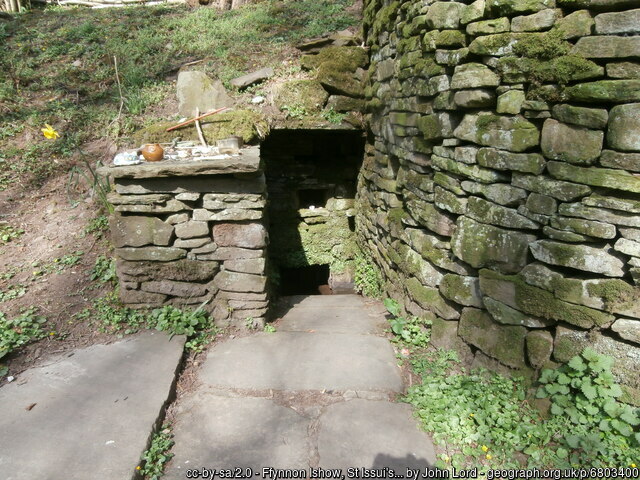 |
Dedication: Saint Issui Location: Patrishow Coordinates: 51.89535N, -3.051W Grid reference: SO277223 Heritage designation: Grade II listed building |
HOME - WALES - BRECKNOCKSHIRE
 |
Dedication: Saint Issui Location: Patrishow Coordinates: 51.89535N, -3.051W Grid reference: SO277223 Heritage designation: Grade II listed building |
Very little is known about St Issui, a hermit who is said to have lived beside Ffynnon Ishow (or, according to some, within Ffynnon Ishow) at some point during the early medieval period, perhaps the 6th century. Local tradition asserts that Issui was murdered at his hermitage by an ungrateful traveller who refused to convert to Christianity, thus earning the Patrishow the early name of "Merthyr Issui", which has been translated as "[place of the] martyrdom [of] Issui". Indeed, the place was called "Merthur Issui" in the 11th century, but, in truth, "Merthyr" in a place-name can mean anything from "burial place" to "shrine", and more probably refers to an early shrine of St Issui, perhaps taking the form of the holy well.
It appears that a church was constructed at Patrishow in the 11th century, and consecrated to St Issui by Herewald, the Bishop of Llandaff; although it is possible that this replaced an older structure, it seems that before this only the well was extant. Almost certainly, Ffynnon Ishow predates this 11th century church, and may have been the earlier shrine that gave "Merthur Issui" its name. In fact, it is rumoured that this church was built using money obtained from the offerings of early pilgrims visiting the holy well, notably using a sack of gold that a French pilgrim, having been cured of leprosy at the well, left as an offering.
Following the Reformation, it appears that Issui's name was effectively forgotten in Patrishow: it was commonly assumed that the church was dedicated to St Patrick. John Ecton, in 1763, said that "Patriceo Capella" was dedicated to "St. Patricius", or St Patrick, in the third edition of Thesaurus Rerum Ecclesiasticarum. Luckily, the well's dedication to Issui was never forgotten, or confused with another saint.
Regarding Ffynnon Ishow itself, almost nothing has been recorded of its early history. There can be no doubt, however, that it was used during the medieval period by pilgrims, as a groat of Henry VI, which was made at some point between 1422 and 1427, was uncovered in the well when it was cleared out in 2013. This was clearly a medieval offering, perhaps in exchange for a miraculous cure through the well's water. Nant Mair, or "Mary's Stream", the stream that runs past the well, probably had some part in a now long-lost medieval ritual. The earliest direct reference to the well's existence that I have been able to find dates from the early 18th century, when Browne Willis, who was doubtful that the church was dedicated to St Patrick, mentioned "a well just by the church, walled and arched over pretty handsomely, called Ishow's well".
The most notable characteristic of Ffynnon Ishow, a feature that was mentioned and described by almost all of the 19th century antiquarians who wrote of its existence, are the niches or recesses in the walls of the structure. Similar recesses can be seen at the Holy Well at Pilleth, and probably would have either held a statue of the saint, or served as depositories for offerings. This indicates that the structure, or at least the main fabric of it, is medieval; the site's Cadwr entry, however, asserts that the current well is "probably a C18 or C19 rebuild". Although it is possible that the site was rebuilt in the 18th century, it seems unlikely, as the well retains certain features that would only have been used by medieval pilgrims, and the site's main fabric was certainly not altered during the 19th century, as is proven by Nicholas Carlisle's description of the well, in his Topographical Dictionary of Wales (1811):
|
St. Ishow's Well is at the bottom of the Hill, walled in on three sides, but open in the front, and covered. In the Walls were recesses, which were, most probably, intended to receive the Presents made by pious Votaries. |
It is more probable that the well was subject to more minor improvements during these two centuries.
Today, the well can still be seen in the valley beneath the church, and is reportedly in good condition. It is worth noting that the location that both Coflein and Cadwr give for this site is incorrect, and is off by about 100 metres, placing the well inside the lych-gate of the church.
|
Access: The well can be accessed via a short path that leads to it from the side of the road. |
Copyright 2025 britishholywells.co.uk